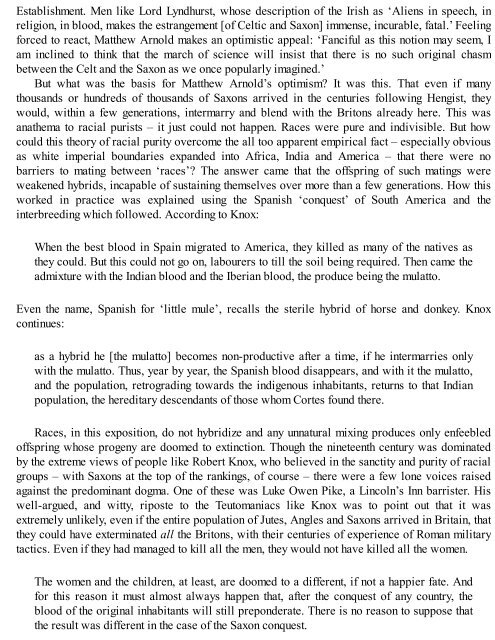You also want an ePaper? Increase the reach of your titles
YUMPU automatically turns print PDFs into web optimized ePapers that Google loves.
Establishment. Men like Lord Lyndhurst, whose description of the Irish as ‘Aliens in speech, in<br />
religion, in blood, makes the estrangement [of Celtic and Saxon] immense, incurable, fatal.’ Feeling<br />
forced to react, Matthew Arnold makes an optimistic appeal: ‘Fanciful as this notion may seem, I<br />
am inclined to think that the march of science will insist that there is no such original chasm<br />
between the Celt and the Saxon as we once popularly imagined.’<br />
But what was the basis for Matthew Arnold’s optimism? It was this. That even if many<br />
thousands or hundreds of thousands of Saxons arrived in the centuries following Hengist, they<br />
would, within a few generations, intermarry and blend with the Britons already here. This was<br />
anathema to racial purists – it just could not happen. Races were pure and indivisible. But how<br />
could this theory of racial purity overcome the all too apparent empirical fact – especially obvious<br />
as white imperial boundaries expanded into Africa, India and America – that there were no<br />
barriers to mating between ‘races’? The answer came that the offspring of such matings were<br />
weakened hybrids, incapable of sustaining themselves over more than a few generations. How this<br />
worked in practice was explained using the Spanish ‘conquest’ of South America and the<br />
interbreeding which followed. According to Knox:<br />
When the best blood in Spain migrated to America, they killed as many of the natives as<br />
they could. But this could not go on, labourers to till the soil being required. Then came the<br />
admixture with the Indian blood and the Iberian blood, the produce being the mulatto.<br />
Even the name, Spanish for ‘little mule’, recalls the sterile hybrid of horse and donkey. Knox<br />
continues:<br />
as a hybrid he [the mulatto] becomes non-productive after a time, if he intermarries only<br />
with the mulatto. Thus, year by year, the Spanish blood disappears, and with it the mulatto,<br />
and the population, retrograding towards the indigenous inhabitants, returns to that Indian<br />
population, the hereditary descendants of those whom Cortes found there.<br />
Races, in this exposition, do not hybridize and any unnatural mixing produces only enfeebled<br />
offspring whose progeny are doomed to extinction. Though the nineteenth century was dominated<br />
by the extreme views of people like Robert Knox, who believed in the sanctity and purity of racial<br />
groups – with Saxons at the top of the rankings, of course – there were a few lone voices raised<br />
against the predominant dogma. One of these was Luke Owen Pike, a Lincoln’s Inn barrister. His<br />
well-argued, and witty, riposte to the Teutomaniacs like Knox was to point out that it was<br />
extremely unlikely, even if the entire population of Jutes, Angles and Saxons arrived in Britain, that<br />
they could have exterminated all the Britons, with their centuries of experience of Roman military<br />
tactics. Even if they had managed to kill all the men, they would not have killed all the women.<br />
The women and the children, at least, are doomed to a different, if not a happier fate. And<br />
for this reason it must almost always happen that, after the conquest of any country, the<br />
blood of the original inhabitants will still preponderate. There is no reason to suppose that<br />
the result was different in the case of the Saxon conquest.
















